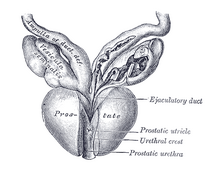User:Mr. Ibrahem/Posterior urethral valve1
| Posterior urethral valve | |
|---|---|
| Other names | Congenital obstructive posterior urethral membrane |
 | |
| Vesiculæ seminales and ampullæ of ductus deferentes, seen from the front. Posterior urethral valves are at the dorsal aspect (back) of the prostatic urethra. | |
| Specialty | Urology |
| Symptoms | Poor feeding, failure to thrive[1] |
| Complications | Chronic kidney disease, incomplete lung development, urinary incontinence, urinary tract infections[1] |
| Usual onset | Present at birth[1] |
| Types | Type I, II, III[1] |
| Causes | Unknown[2] |
| Risk factors | Family history.[2] |
| Diagnostic method | Ultrasound, voiding cystourethrography[1][2] |
| Differential diagnosis | Other causes of oligohydramnios, vesicoureteral reflux, Prune–belly syndrome, ureteric stenosis[1] |
| Treatment | Urinary catheter, surgery, management of complications[1] |
| Prognosis | Variable[1] |
| Frequency | 1 in 5,000 male births[1] |
Posterior urethral valve (PUV) is a disorder were the urethra in a newborn male is blocked by a fold of tissue.[1] Symptoms after birth may include poor feeding or failure to thrive.[1] It may be associated with urinary retention, chronic kidney disease, incomplete development of the lungs, urinary incontinence, or urinary tract infections.[1]
How and why the disorder forms in unclear.[2] Risk factors include a family history.[2] They can be divided into three types based on the proposed origin of the fold of tissue.[1] The potential origins of the fold; however, is disputed as of 2020.[1] Diagnosis may occur before birth by ultrasound or after birth via voiding cystourethrography.[1]
Surgery may be carried out before birth; however, results are mixed.[1] After birth the bladder may be drained with a feeding tube.[1] Other efforts may be required to address electrolyte or breathing problems.[1] Surgery is required to remove the fold of tissue and potentially to treat any vesicoureteric reflux.[1]
Posterior urethral valve occurs in about one in 5,000 male births.[1] The condition was first described in 1717 by Giovanni Battista Morgagni.[1] The classification into types occurred in 1919 by Hugh Young.[3]
References[edit]
- ^ a b c d e f g h i j k l m n o p q r s t u Bingham, G; Rentea, RM (January 2020). "Posterior Urethral Valve". PMID 32809716.
{{cite journal}}: Cite journal requires|journal=(help) - ^ a b c d e "Orphanet: Posterior urethral valve". www.orpha.net. Retrieved 22 January 2021.
- ^ Puri, Prem (2003). Newborn Surgery, 2Ed. CRC Press. p. 855. ISBN 978-1-4441-1389-1.
